Comfrey (Symphytum officinale)
Comfrey is a perennial that is as beautiful as it is useful. Because of its gorgeous flowers, it could be used as a landscape plant (for those interested in having a medicinal garden that is “hiding in plain sight”). It can be harvested throughout the growing season, but it typically isn’t harvested when it is in flower. Although individual leaves can be harvested before the plants are well established, one shouldn’t cut all the leaves of a plant until it is well established. They may be used fresh or dried; and they may be made into tea, tincture, poultice, or salve. When drying comfrey leaves, dry them in a single layer with none of the leaves touching each other; and make sure that there is plenty of air circulation above and below the leaves. Even so, you might find that a lot of the leaves turn brown while they’re drying, instead of staying a nice green. Don’t use the browned ones for medicinal purposes; they will still be fine for animal feed, though (chickens, sheep, and goats love them).

Comfrey
There is a lot of controversy about whether comfrey can be used internally. Most of the herbal books and everything put out by the FDA makes it sound like the internal use of comfrey will absolutely kill you. It is true that comfrey contains alkaloids that can potentially harm the liver if taken internally. However, this is only a huge concern with the comfrey hybrids such as Symphytum x uplandicum. In fact almost all of the toxicity testing that has been done using various comfrey hybrids. True comfrey (Symphytum officinale) is very low in the problematic alkaloids; in fact, comfrey leaves were used as food in Europe for centuries. The roots are higher in alkaloids than are the leaves, but in true comfrey even the roots are low in alkaloid content. So to be safest, use only true comfrey and avoid the hybrids; and use the leaf rather than the root.
All of the above said, it is recommended that comfrey not be used either internally or externally during pregnancy or breastfeeding (if in need of comfrey while pregnant or nursing, use it homeopathically instead; it’s known as Symphytum officinale homeopathically). If you have comfrey growing at your home and you’re not sure if its true comfrey or a hybrid, one way to figure it out is to determine how it spreads. All comfrey spreads in clumps, the same way that chives do. However, true comfrey also spreads via seeds that will germinate and cause plants to pop up all over your garden or yard. The hybrid comfrey sets seed, but the seeds are sterile; thus it won’t show up anywhere except exactly where you planted it.
As far as the uses for comfrey, it is excellent for the healing of shallow cuts, abrasions, broken bones, burns, bruises and injured ligaments and tendons. It can be made into a poultice for drawing out splinters, infection, and venom from bites and stings; and the salve is useful for both healing and for pain relief.
Mullein (Verbascum olympicus, Verbasum thapsus)
Mullein loves sandy soil and will grow and self-seed like crazy where the soil is sandy. It really doesn’t like clay; so if you have clay soil but want to grow mullein, consider either making a bed (raised or otherwise) that is amended with a bit of sand. Every part of the plant is useful medicinally, except for the seeds (which are toxic). The plant is biennial, so it flowers in the second year and then dies. The flowers are useful for making an oil that helps to heal ear infections. The dried mullein flowers are usually combined with garlic and then steeped in warm olive oil for a period of time. When harvesting mullein flowers, only harvest the top third or so of the flower head so that the rest of the head can set seed and hopefully reseed the plant.
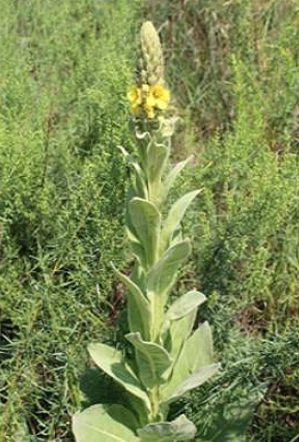
Mullein
Mullein leaves can be harvested during the first year of growth, or in the second year before the plant sends up its flower stalk. They may be used fresh or dried, but they are pretty difficult to dry because they are so thick. I have read that if you slice them down the midrib, they dry better. Medicinally, the tea is preferred to the tincture. If you wish to tincture the dried leaves, they must be powdered first. (Dried cut-andsifted mullein is so absorbent that it sucks up way more liquid than other dried herbs; so you’d have to add so much liquid that you’d end up with a tincture that is quite dilute, and thus not as strong as a tincture made from powdered leaf). Mullein leaf is useful for pretty much any illness affecting the lungs or the throat. It is excellent for colds, coughs, sore throats, pneumonia, bronchitis, pertussis, and asthma. For mild to moderate asthma attacks, the leaves can be burned and the smoke inhaled in order to try to open the constricted airways.
Mullein root is excellent for bedwetting in children and for urinary incontinence in people of all ages. The root is dug in the fall of the first year, or in the spring of the second year before the plant sends up its flower stalk.
St. John’s Wort (Hypericum perforatum)
St. John’s wort is so named because it flowers right around the feast day of St. John the Baptist, which is June 24. So that’s how I remember when to harvest the plant. (I see June 23 on my calendar and I’m like, “Oh, I have to harvest my St. John’s wort tomorrow!”) You harvest the flowers and the top few inches of leaves and stem. It is best tinctured fresh, or made into an oil or salve when still fresh because it loses its medicinal properties quickly once dried.

St. John’s Wort
St. John’s wort is in the class of herbs known as nervines, which work on the nervous system. It is excellent for pain relief, particularly in nerve-rich parts of the body. It has long been used for depression, and it may help with Seasonal Affective Disorder (do not use if taking pharmaceutical antidepressants). It can also be used as an antiseptic on cuts, scrapes, and wounds.
In some people, St. John’s wort can cause photosensitivity (either from using it internally or even from just harvesting the plant), so this is something to be aware of and watch out for.
St. John’s wort is a perennial and is fairly hardy. However, it does not compete well with weeds or other plants; so if you plant it, make sure to keep it well weeded.
Purple-flowered Oregano (Origanum vulgare)
Oregano is perennial. Origanum vulgare is a different species from culinary oregano. The way you tell the difference is that culinary oregano has white flowers, whereas those of Origanum vulgare are purple. (This doesn’t mean that culinary oregano is medicinally useless, but it is weaker than the purple-flowered variety.) Being a member of the mint family, Oregano spreads by both runners and seeds; so either plant it where it has room to run, or find a way to contain it so that it doesn’t take over your garden.
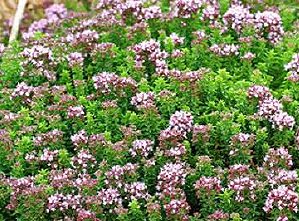
Oregano
The aerial parts of the plant are harvested when in flower, and they can be used fresh or dried. Tea, tincture, poultices, and salves are all good ways to use it. The plant has antibacterial, antiviral, antiseptic, antifungal, and anthelmintic (antiparasitic) properties; so it is useful for a wide range of ailments (colds, flus, wounds, cuts, scrapes, indigestion, and so on). The tea and tincture are a wonderful antiseptic (dilute the tincture before using on broken skin, or it will hurt like the dickens). Oregano can also be used in food preservation.
Garlic (Allium sativum)
Garlic is perennial, is easy to grow and is not fussy. In my experience, it even competes pretty well with weeds. There are hardneck varieties (which set little garlic bulbils on the top of “flower stalks” each year) and softneck varieties (which do not set bulbils). I grow the hardneck varieties. Although they cannot be braided the way the softneck varieties can (you know the garlic braids that you see hanging in the kitchens of Italian families in the old movies), the hardneck varieties tend to store for longer periods. Also, the topsets can either be used for food or medicine; or they can be planted in order to rapidly increase the size of your garlic bed. Lots of people who grow hardneck garlic cut off the “flower stalks” (technically known as “scapes”) before the bulbils set. This leads to the formation of larger garlic bulbs in the ground. The scapes can be used in cooking, or they can be used in floral arrangements.

Garlic
Garlic is antibacterial, antiviral, antifungal,antiseptic, and anthelmintic . It helps with colds, flus, thrush, gastrointestinal infections, and UTIs. For these purposes, it is usually used raw. It is also good for asthma, hay fever, heart conditions, poor circulation, and high blood pressure, for which purposes it is usually used cooked. For topical use for cuts, scrapes, and wounds, it can be made into a poultice; or a bulb can be cut in half and simply rubbed on the wound (this will sting). Garlic is considered to be prophylactic against the flu and against cancer.
As mentioned above, garlic is good for ear infections (either used alone or with herbs such as mullein or willow bark). It can be made into an infused oil for such purposes; but if one is in a hurry, it might be worth squeezing a few drops of fresh juice into the infected ears while waiting for the oil to infuse.
For fresh use, garlic should be peeled, chopped or crushed, and then left in the open air to rest for maybe 10 or 15 minutes. This is because certain enzymes are released by this process, and the enzymes are useful for healing. For those who don’t like the taste of garlic or who get digestive upset from it, it can be made into a strong tea and used as a hand or foot soak. The soak should be made with water that is as hot as can be tolerated, and the hands or feet should be soaked until the water has cooled. I have read that within 5 or 10 minutes of starting the soak, the garlic can be smelled on the person’s breath.
Incidentally, garlic leaves can also be used for culinary or medicinal purposes, although they’re not as strong as the bulbs or topsets. Garlic is also useful in food preservation.
Onion (Allium cepa)
Onions are medicinally useful raw or cooked. Yellow onions are medically more useful than white or red onions; and the more pungent the onion, the better (sweet onions like Vidalias are yummy but medicinally pretty useless). I can’t imagine using onions for tea, but they can be used as a poultice for wounds (raw) or chest infections (cooked; directions are in Richo Cech’s book “Making Plant Medicine”). The leaves can be used as well as the bulbs, but the leaves are weaker. (The leaves can also be used like chives for culinary purposes; and chives have medicinal properties similar to those of onion leaves).

Onion
Two of my favorite ways to use onions are as slices applied to the feet during illness, and cut in half and placed on a plate in a sickroom. First, the sickroom application: When someone is pretty ill, or even just beginning to come down with a cold or something, we get 2 (if huge) to 4 (if small) onions, peel them, cut them in half, and put them cut-side-up on a plate. We set the plate near the sick person in the sick room. If the person has a sore throat, or a chest infection, or a sinus infection, we take the newly cut surface of the onion and rub it all over the infected area (throat, chest, forehead, nose, cheeks, whatever). The onion juice soaks in like an essential oil and jump-starts the healing process. This onion-juice-smearing can be done as often as necessary. The cut onions will also both pull germs out of the air and put their essential oils into the air (much like a diffuser will). Replace the onion halves every 8 – 12 hours, depending on how sick the person is.
The second way we use onions when someone is pretty sick is to slice them in rounds like you would for hamburgers, and then cover the soles of the feet with them. Pull on a pair of socks; and change out the slices every 6 – 8 hours, depending on how sick the person is.
For ear infections: You can cut an onion and squeeze a few drops of the fresh juice into the ears.
Ordinary onions are biennial. It’s tricky to save seed from them, and they are kind of a pain to start from seed. Onion seed is also very short-lived; it is only viable for about a year. So for those interested in growing onions for culinary or medicinal use, perennial onions are a good choice to consider. My favorite varieties are the Egyptian walking onion and the yellow multiplier onion (also called the yellow potato onion).
Thyme (Thymus vulgaris)
Thyme is perennial.Thyme is perennial. From what I have read, English broadleaf thyme is the best medicinal variety to grow in USDA Zone 6 and warmer; and German winter thyme is the best variety for Zone 5 and colder. The German winter thyme does well here in Zone 5A. But thyme is kind of fussy; it doesn’t like to be dug up and moved around the garden, and it gives up the ghost entirely if weeds even look at it funny. But if you keep it weeded and baby it a little, it will be a very productive plant for you. It is definitely one that I wouldn’t want to be without.

Thyme
Thyme can be used fresh or dried, and usually as a tea or tincture; and it is the aerial parts that are harvested. I have made tincture from it, but I almost always use it as a tea (the exception is when I use the tincture for topical applications such as cuts, scrapes, and mosquito bites). It is a nervine herb, so it is good for pain and for headaches, including migraines. It is antibacterial, antiviral, antifungal, antiseptic, and anthelmintic. As an expectorant, it is good for congestion in the lungs; and as a decongestant, it is good for nasal congestion. It is prophylactic for the flu, and it is good for all sorts of respiratory illnesses (colds, flu with respiratory symptoms, bronchitis, pneumonia, pertussis, asthma). It’s also helpful for gastrointestinal infections, diarrhea, and UTIs.
Thyme should not be used medicinally during pregnancy.
The best sore-throat remedy that I know of is a tea made from thyme. You use 2 teaspoons of dried thyme and 1/4 teaspoon of sea salt. Cover with 8 ounces of boiling water, and steep until cool enough to gargle with. Use about 1/4 cup at a time, and gargle until the 1/4 cup is gone (should take about 5 – 7 minutes; swallow after gargling).
Tulsi, Holy Basil, Sacred Basil, or Indian Basil (Ocimum tenuiflorum, formerly Ocimum sanctum; Ocimum africanum; Ocimum gratissimum)
Tulsi is in the class of adaptogenic herbs, which are herbs that help the body adapt to stress of whatever kind (lack of sleep, worry, overwork, illness, grief, etc.). It can be grown in much of the country; but except in warm climates, it should be treated as an annual instead of the perennial that it is in its native range. Even so, the aerial parts can be harvested two or three times during the growing season even in Zone 5.
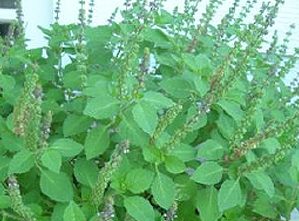
Thyme
Tulsi is useful in all kinds of acute illnesses (colds, flus, indigestion, diarrhea, bronchitis); and according to Richo Cech, “[it is] considered to be prophylactic against epidemics, such as cholera, influenza, and malaria.” He continues, “Used on a regular basis, as tea or tincture, holy basil is likely to be prophylactic against prostatitis, cancer, and leukemia….”
This is one of the herbs that I put in my daily tea, of which I try to drink 3 – 4 cups every day but Sunday (because the body needs a weekly rest from medicinal herbs that are taken for an extended period). I can definitely tell when I run out and forget to reorder because when I haven’t drunk it for a while, I tend to “succumb” to the busy-ness of life more easily and I get more colds and such.


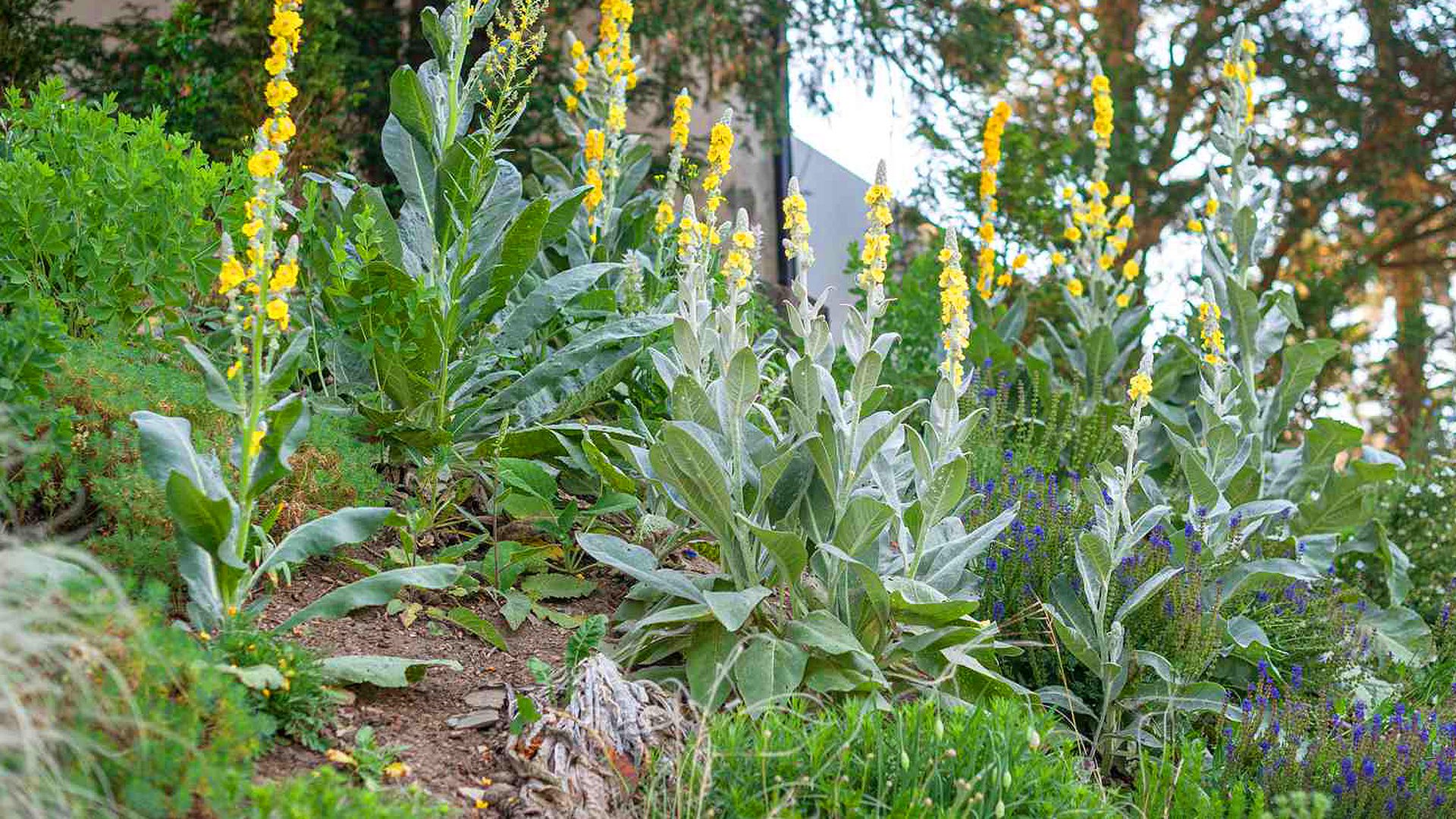








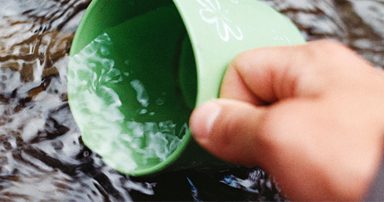









0 Comments